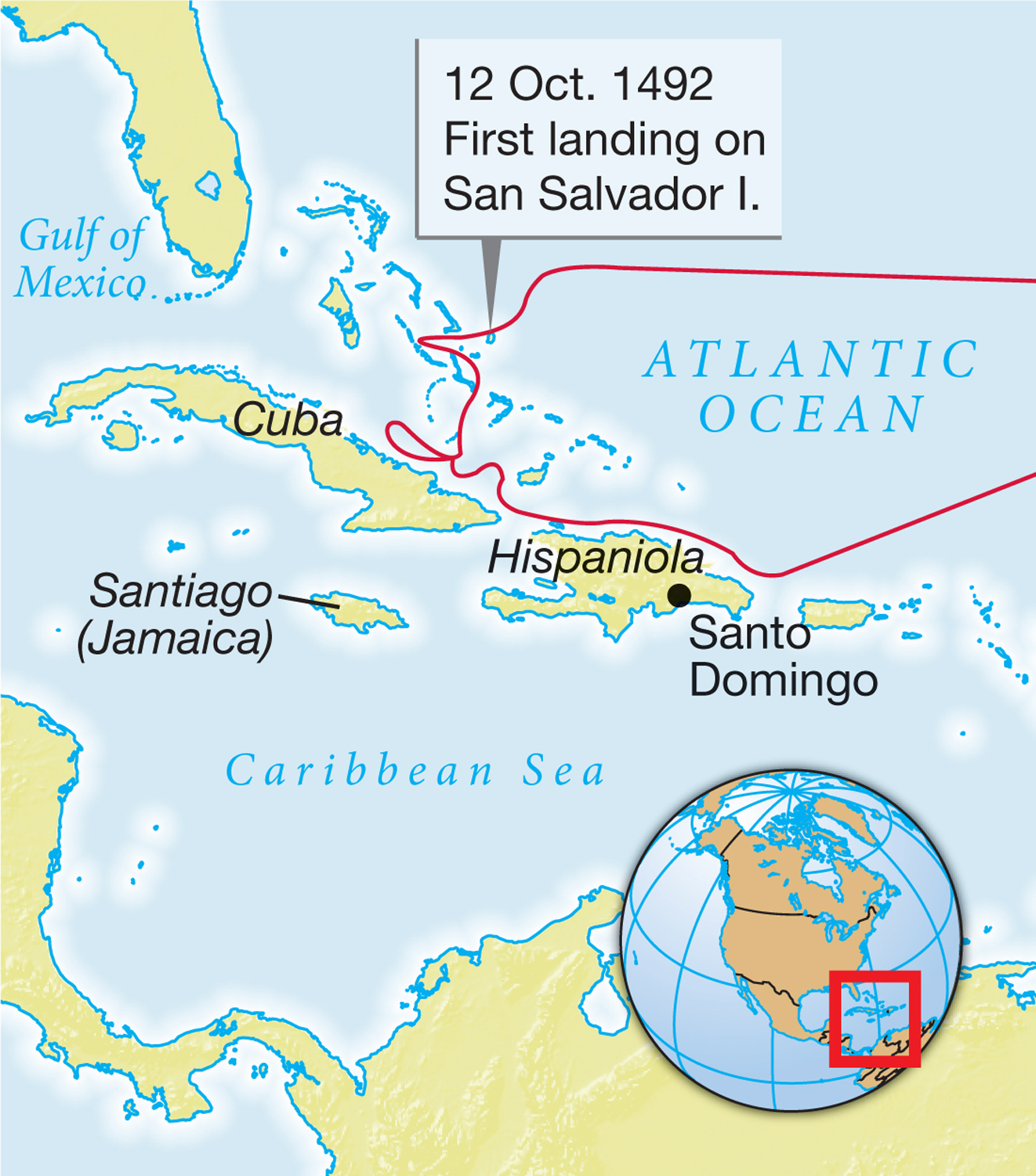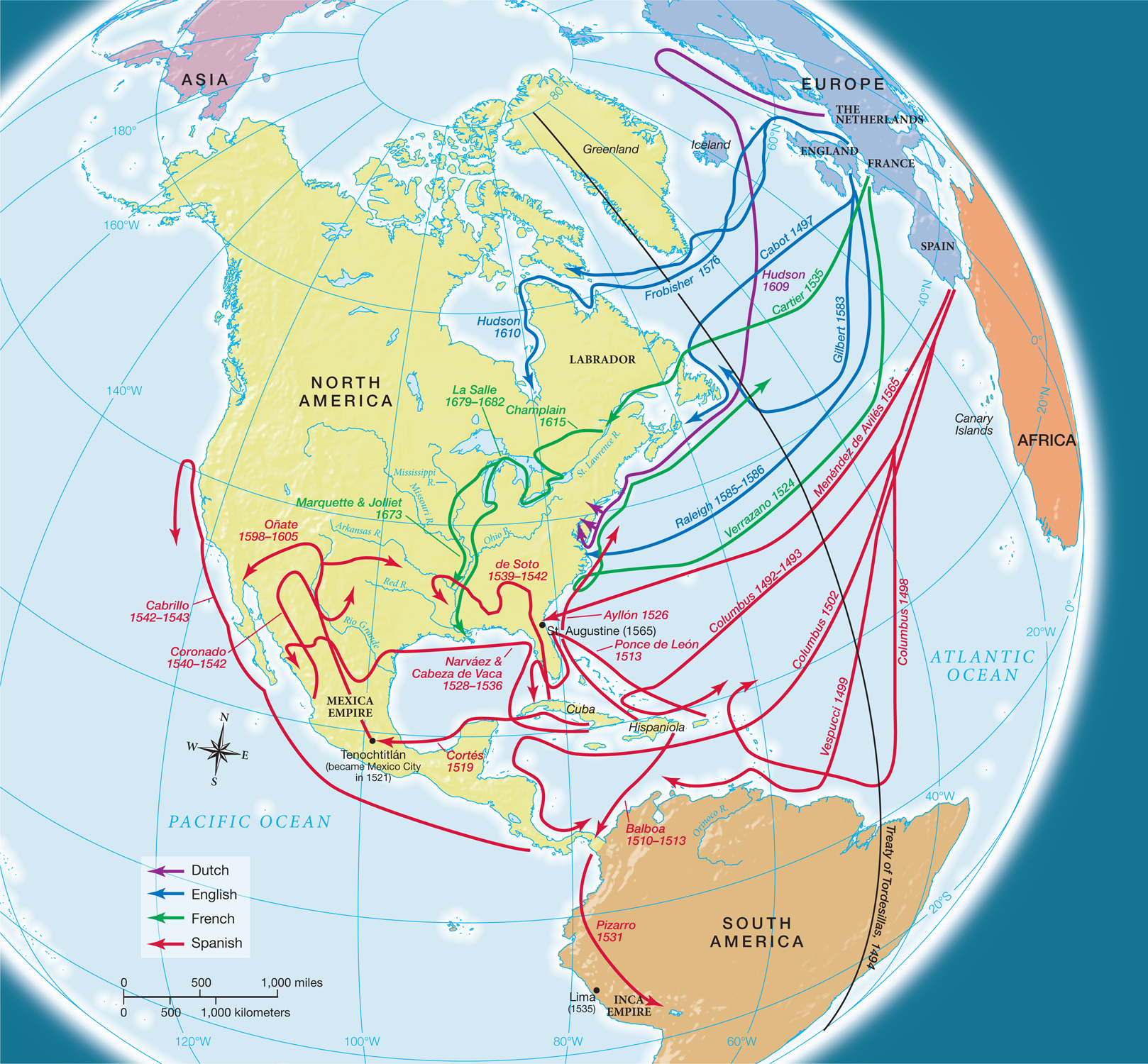The American Promise:
Printed Page 30
The American Promise Value
Edition: Printed Page 30
The Explorations of Columbus
Columbus went to sea when he was about fourteen and eventually made his way to Lisbon, where he married Felipa Moniz, whose father had been raised in the household of Prince Henry the Navigator. Through Felipa, Columbus gained access to explorers’ maps and information about sailing in the tricky currents and winds of the Atlantic. Like other educated Europeans, Columbus believed that the earth was a sphere and that theoretically it was possible to reach the East Indies by sailing west. With flawed calculations, he estimated that Asia was only about 2,500 miles away, a shorter distance than Portuguese ships routinely sailed between Lisbon and the Congo. In fact, the shortest distance to Japan from Europe’s jumping-
In 1492, after years of unsuccessful lobbying in Portugal, Spain, England, and France, Columbus finally won financing for his journey from the Spanish monarchs, Queen Isabella and King Ferdinand. They saw Columbus’s venture as an inexpensive gamble: The potential loss was small, but the potential gain was huge. They gave Columbus a letter of introduction to China’s Grand Khan, the ruler they hoped he would meet on the other side of the Atlantic.

After frantic preparation, Columbus and his small fleet—

Columbus claimed possession of the island for Spain and named it San Salvador, in honor of the Savior, Jesus Christ. He called the islanders “Indians,” assuming that they inhabited the East Indies somewhere near Japan or China. The islanders called themselves Tainos, which in their language meant “good” or “noble.” An agricultural people, the Tainos grew cassava, corn, cotton, tobacco, and other crops. Instead of dressing in the finery Columbus had expected to find in the East Indies, the Tainos “all . . . go around as naked as their mothers bore them,” Columbus wrote. Although Columbus concluded that the Tainos “had no religion,” in reality they worshipped gods they called zemis, ancestral spirits who inhabited natural objects such as trees and stones. The Tainos had no riches. “It seemed to me that they were a people very poor in everything,” Columbus wrote.
What the Tainos thought about Columbus and his sailors we can only surmise since they left no written documents. At first, Columbus got the impression that the Tainos believed the Spaniards came from heaven. But after six weeks of encounters, Columbus decided that “the people of these lands do not understand me nor do I, nor anyone else that I have with me, [understand] them.” The confused communication between the Spaniards and the Tainos suggests how strange each group seemed to the other. Columbus’s perceptions of the Tainos were shaped by European attitudes, ideas, and expectations, just as the Tainos’ perceptions of the Europeans were no doubt colored by their own culture.
Columbus and his men understood that they had made a momentous discovery. In 1493, when Queen Isabella and King Ferdinand learned Columbus’s news, they were overjoyed. With a voyage that had lasted barely eight months, Columbus appeared to have catapulted Spain into a serious challenger to Portugal, whose explorers had not yet sailed to India or China. Columbus was elevated to the nobility, given the title “Admiral of the Ocean Sea,” and the seven Tainos he brought to Spain were baptized as Christians and King Ferdinand became their godfather. Soon after Columbus returned to Spain, the Spanish monarchs rushed to obtain the pope’s support for their claim to the new lands in the West. When the pope, a Spaniard, complied, the Portuguese feared that their own claims to recently discovered territories were in jeopardy. To protect their claims, the Portuguese and Spanish monarchs negotiated the Treaty of Tordesillas in 1494. The treaty drew an imaginary line eleven hundred miles west of the Canary Islands (Map 2.2). Land discovered west of the line (namely, the islands that Columbus discovered and any additional land that might be found) belonged to Spain; Portugal claimed land to the east (namely, its African and East Indian trading empire).

Isabella and Ferdinand moved quickly to realize the promise of their new claims. In the fall of 1493, they dispatched Columbus once again, this time with a fleet of seventeen ships and more than a thousand men who planned to locate the Asian mainland, find gold, and get rich. Before Columbus died in 1506, he returned to the New World two more times (in 1498 and 1502) without relinquishing his belief that the East Indies were there, someplace. Other explorers continued to search for a passage to the East or some other source of profit. Before long, however, prospects of beating the Portuguese to Asia began to dim along with the hope of finding vast hoards of gold.
Nonetheless, Columbus’s discoveries forced sixteenth-